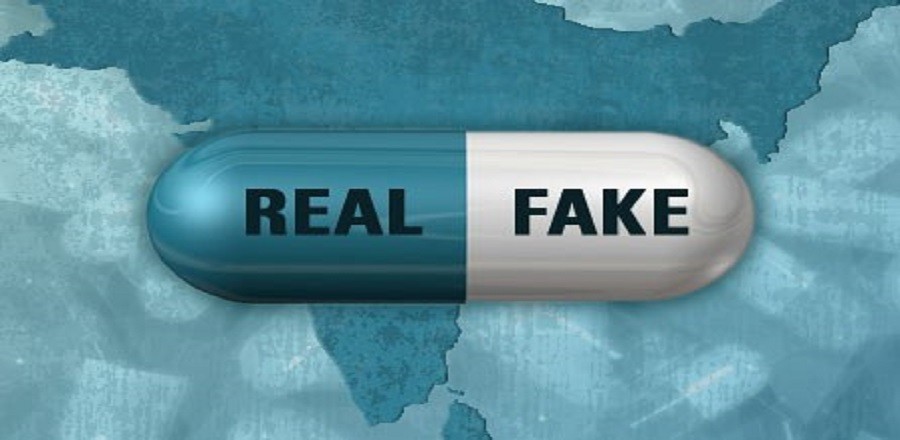Is your medicine a fake?
June 21, 2017 | Expert Insights

Drug Counterfeiting is a worldwide phenomenon having both social and economic impacts, and India is not an exception to it. The counterfeit drug industry is estimated to be worth $200 billion a year and has been defined as the “The crime of the 21st century” (ACG Report 2003). Asia is the single largest producing region for counterfeit drugs. Surprisingly, 75% of counterfeit drugs supplied worldwide have origins in India, followed by 7% from Egypt and 6% from China. Pharmaceutical industry is considered as the most counterfeited industry in India.
Counterfeit Medicine
The WHO defines counterfeit medicine as “one which is deliberately and fraudulently mislabeled with respect to identity and/or source to make it appear to be a genuine product”.
One may term these substances as ‘Counterfeit’, ‘Fake’, ‘Spurious’ or ‘Sub-standard’ drugs, or in whatever other names one may wish to. These ‘Fake medicines’ that we may end up buying, without any inkling that instead of curing the ailments, these products can push us into serious health hazards, quite contrary to what we and our doctors hope for. The bottom-line is that such products in the guise of drugs could kill consumers.
INTERPOL estimates that fake medicine kills more Indians each year than Terrorism.
Both crime and big money are involved in this life-threatening menace. Fake drug makers, who run this deadly trade undercover, use sophisticated tools and technologies and are well equipped to operate stealthily.
Distressingly, this crime not only poses a serious threat to public health, but as per growing evidence, is increasingly linked to an array of organized criminal groups and terrorist entities. According to U.S. and E.U. homeland security experts, counterfeit today is the single largest source of funding for terrorist organizations.
A fake medicine is like a termite eats into public health, the economy of a country, the reputation of the nation too
Drug Counterfeiting in India
One takes medicine to live, not to die. But in India, lakhs of people die taking medicine, which is fake and abundantly available in the market.
It has been observed that the issue of fake drugs is more common in those countries, where the regulatory enforcement mechanism is weak. India, is one such country.
In India ‘Bhagirath palace’ Chandni Chowk, New Delhi is said to be the hub for counterfeit drugs in India. According to a study conducted by SSOCHAM (Associated Chamber of Commerce and Industry of India), the current market size of counterfeit products in India is around Rs 45,000 Crore. Delhi alone accounts for 70% of the total production of counterfeit products in the country and the rest from Bihar, West Bengal, Uttar Pradesh and Gujarat.
Counterfeit drugs contribute to about 25 % of the domestic medicines, killing up to 1 million people in a year in the country. Fake drugs were once confined to exotic and costly pills like Viagra has now proliferated to cough syrups, vitamin supplements and painkillers popular drugs being Crocin, Betadine, Cosavil syrup and many more . We can now find countless duplicate products with similar packing, color, name, logo and design as the original branded products. Thus, manufacturers and suppliers of these duplicate products earn large profits.
India, being the world’s largest supplier of generic drugs, has become an epicenter for counterfeit and fake drugs. A study conducted by ‘The Lancet’ reported that over 1 in 3 anti-malarial drugs sold in southeast Asia are fake. Around 7% of the drugs tested in India was found to be of poor quality with many being fake. India reportedly records 1.5 million cases of malaria every year.
Can you imagine a world where the most essential therapies to treat tuberculosis, malaria, HIV, pneumonia, diarrhea and other killer infectious diseases become ineffective?
The scenario is frightening. The risk is real. The health and safety of our future generation is at stake.
Assessment
Although, recent efforts to deal with counterfeit involve both information and material technologies. To date, no technique has proven effective in eliminating the problem. As the approach to the problem is skewed. Using technology alone may not be sufficient deterrence in combating this problem.
The main issue with the existing approaches is that they are static. Earlier, we could take some comfort in the fact that fake drugs stood out from the genuine drugs. Now the fake drug is actually so much more sophisticated than the real one that buyers are “guided towards the fake because fake was better made than the genuine”, says a British holography expert Manufacturers of counterfeit drugs.
As the penetration of Internet keeps increasing at a galloping speed in our country, unregulated online sales of ‘fake drugs’ in the guise of ‘licensed medicines’, pose a very real threat to public health and safety. If and when online sales of medicines are legalized, enforcement of all rules and laws in this regard need to be very stringent with exemplary punitive actions prescribed, for even slightest violations.
Both licit and illicit products are funneled into the legitimate supply chain through freight forwarders, shipping companies, importers, diverters, tertiary & secondary wholesalers, and individual & online purchasers. In this world of stretched supply chains, it is clear that more needs to be done.
It is time to step back and reflect on whether we have rightly defined the problem. Have we really understood who our adversary is?
It is possible that lack of sensitivity to the issue of drug counterfeiting by industry and government, may be responsible for loss of life.
In tandem, the DCGI and other regulatory and enforcement agencies in the states, healthcare professionals, patients, all pharmaceutical manufacturers, drug distributors, wholesalers and retailers should join hands to play a proactive role in curbing the menace of ‘fake medicines’ that victimize the innocent patients.
No Wolf in sheep’s clothing must be allowed coming anywhere in the vicinity…
Source: Synergia Foundation








Comments